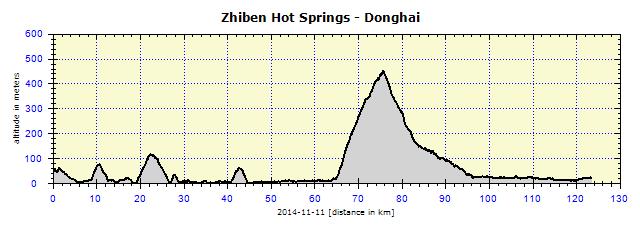
Nothing compares to the simple pleasure of a bike ride. J.F.Kennedy
Search this website
Taiwan, East Coast
Taoyuan, Bali, Tamsui, Yeliu, Keelung, Ruibin, Bitou, Fulong, Dali, Suao, Nafangano, Nanao, Taroko, Tianxiang, Taroko, Hualien, Chenggong, Taitung, Zhiben Hot Springs, Donghai
Transfer to Taiwan
I got up at 06:00, made a noodle soup, after that ate a yogurt and before 07:00 I carried down the panniers with the folded cardboard boxes to the hotel garage. The Airport was nearby. I loaded the boxes on to the rack, with the sleeping bag pannier on top of them. I did not even secure them properly. It was not raining, only the strong wind forced me to stop in open areas and push the bicycle instead. Everything went as planned. I arrived at the International Airport at 08:00. I double-checked that the flight was registered in the reservation system and, with an easy mind, packed up my luggage. I tested a new – innovative – packing technique: half-box. I cut the bicycle box in half and threw one half away. I used the box part as an underlay for the sensitive bicycle parts – crank and rear derailleur. To stabilize everything, I left the empty panniers on that supported side. It all went tremendously, I even received help from an initiative Korean who held my bicycle while I wrapped it in the shrinkwrap and at 09:45 I was already dressed in civilian clothes armed with two large packages. I rewarded myself with an already prepared beer and expected an easy check-in.
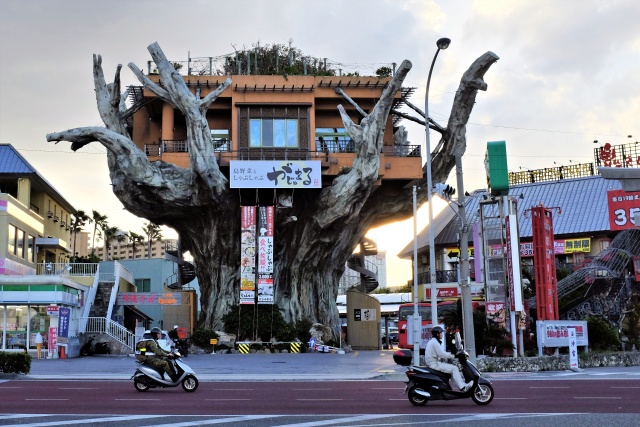
Naha: A pub on an artificial tree
Well-hidden Lighter
From checking in at Sapporo five years before, I knew that Japanese go after lighters in luggage. I left one of mine in the hotel but the second one must have been somewhere and I could not find it. The bicycle did not fit into the scanner, so they cut the wrapping, felt inside the package and were satisfied. The box with my things fared a bit worse – first they removed the batteries, which I had to take on board with me (new security regulation). Then they took the WD from me. I was not sure why they did not like this bicycle oil, probably because of the spray can. The finale was in the name of a 5-phase search for the missing lighter, which was finally found. As I had learned from my previous flight, I retained the rest of the shrinkwrap and tape and repacked the box.
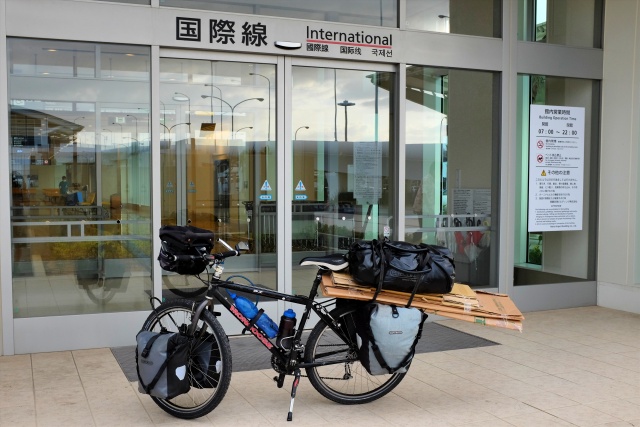
Naha: I arrived at the Airport all right, and so did the folded boxes
Checking in with China Airlines was also interesting. First they tried to convince me that I needed a visa for Taiwan. We argued for so long, until the shift leader came and found in their system that I did not need a visa for a stay not exceeding one month. They tried to tell me that I would certainly be staying longer than one month. I took out the print-out of my electronic flight ticket and pointed at the departure from Taipei on November 26. This had to be rechecked by the boss (she must have been the only one who could read Roman characters), saying that I would have to defend this with the Taiwan immigration authorities. And finally they charged me for 8 kg overweight luggage (I had a total of 32 kg, the limit was 25 kg). This cost about 2000 CZK ($100), the same amount as I usually am charged for a bicycle. Luckily I had one more beer with me, so I washed it all down and boarded the Airbus A340.

Naha: The bike was packed in a “half-box style”
The flight took less than two hours. I stood in line for Immigration for about one hour in expectation that they would come up with some other problems. I knew that every unfilled part on their form would be suspicious, so I stated that my place of stay was the Hotel Hilton, Taipei. That one should be there for sure. The female officer stamped my passport, had no questions and I entered Taiwan. First I withdrew cash from the ATM: one Taiwan New Dollar cost 72 Czech cents ($0.036), I took out 10 000 TWD. This proved to be a good move, as no combini seemed to accept credit cards. The bicycle was ready to use in about one hour. The hardest labor was pumping the tires. I use a super-light pump (5 dkg), but to use it to pump up a pressure of 2.5 atmospheres is physically demanding. However, the airlines always insist that the tires need to be flat – I am not sure why, the pressure in the luggage compartment is the same as in the passenger cabin. The Tourist Office provided me with a map of Taiwan and Taipei, eagerly adding a map of the best bike paths and a list of hostels.
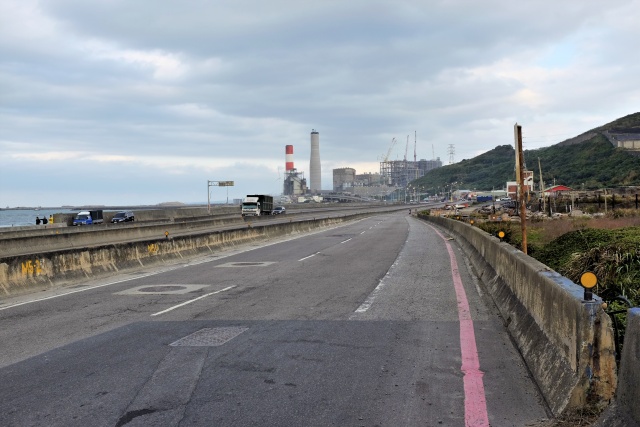
Near Bali: Coastal road, highway on the left
I walked out of the Airport, there were roads of several lanes everywhere. I could not distinguish what was a highway and what road cyclists were allowed on. A policewoman pointed me in an approximate direction. That was no use – I got on to a road leading below the landing strip where cycling was forbidden. The underpass also had a very narrow pedestrian section, I got stuck in it with my panniers several times and pushed the bicycle through.
Only after I got out of the Airport did I start engaging in the question of where I was going. I was not keen on Taipei; I had not booked any accommodation there. Instead I entered Bali District, the nearest seaside suburb, into my GPS. First impressions were quite terrible. I cycled through the industrial periphery, lorries, demolished houses, dust and dirt. The nasty stench was the hardest to survive. Maybe it was some sort of a local spice which I would later get used to. A highway ran along the seashore. On both sides were minor roads with signs allowing cyclists. I was looking out for a site to camp. There were some spots, but no running water and not even public toliets — a luxury which I had got used to.
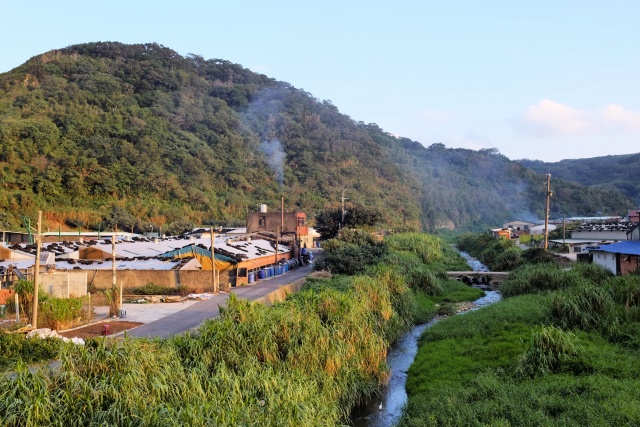
Near Bali: Roadside settlement
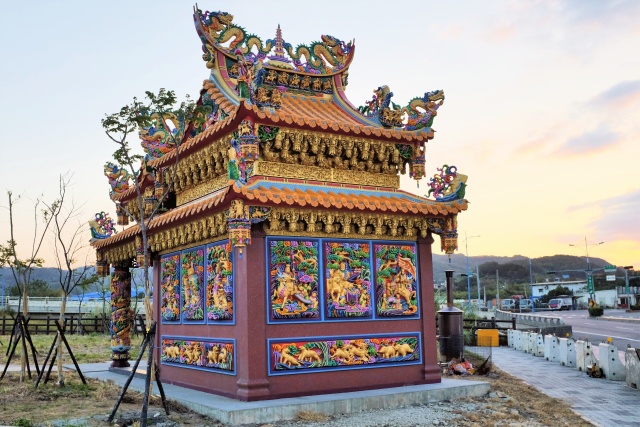
Bali: Small church
"Bali is a big district, I'll find somewhere to sleep," I thought to myself. In any case, I noted in my GPS three possible sleeping spots I'd passed. The time zone is 1 hour behind Okinawa, so dusk arrived very early, at 17:30 already. Heavy traffic, especially people on scooters pushed themselves through almost impossibly narrow gaps between the cars. I had all the lights on the bike switched on, yet I still did not feel quite safe. The cardinal question was what would the Chinese symbols for "hotel" look like? I did not find any hotels on my way, I even tried to recognize them by looking into the lighted spaces of various buildings instead of at the signs. The GPS located some hotels as being only 2–3 km distant in a straight line on the map. However, when I entered the navigation mode, it became more than 12 km of cycling, as they were located across a wide river.
Kindred Souls
Cycling through this city started to be really dangerous. I turned towards the river, ate something from a market stall, bought a beer in a combini and it seemed as if sleeping in a park was my only option. A bike path ran along the river. I found a good spot, but something was pulling me on further. As I trust my instincts, I did not resist it. 5 km later I arrived at Frog Café — a cyclists' café. I went in to ask about accommodation nearby. A boy and a girl (Midori), who could speak very good English, were working there. She immediately sat down at her computer, asking me what my price range was. "It should not be too expensive, I can always sleep in a park," I told her. Lucky me, she answered: "You do not need to go anywhere, we have a shower here and you can pitch your tent in front of our Café." "Great, I'll pay you for this," I said. "No way! Your kind of traveler can always stay free of charge." At least I ordered some food there (for which I received a 20% discount) and purchased a post card for my better half. Thanks to their WiFi, which they left on even after the Café closed, I could update my blog, which you are now reading. And they even rushed off to a Family Mart to buy me the beer, which they did not offer on their menu, and refused to take any payment for it. Simply, cyclists at heart, unbelievable by our standards. Their main business was bicycle and equipment rentals to people who wanted to cycle around the island. The boy could not speak any English, but he knew Formosa from a cyclist's viewpoint and gave me good advice about the dangerous sections which, however, could not be avoided.
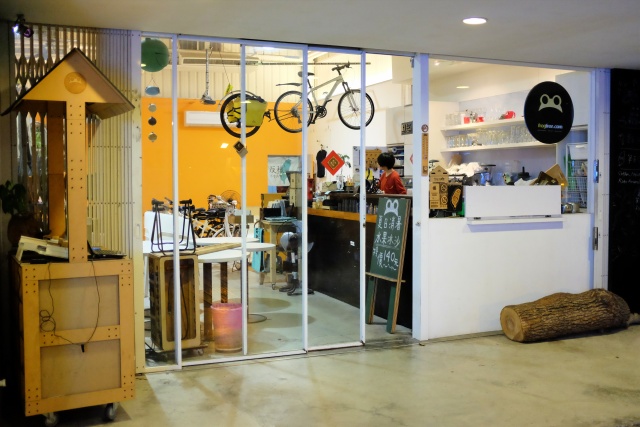
Bali: Frog Café
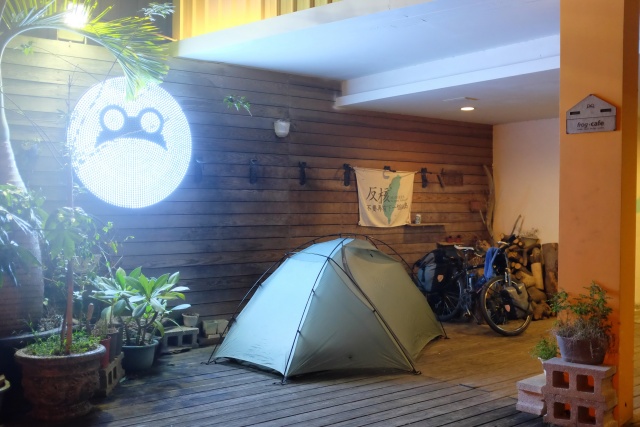
Bali: My tent in front of Frog Café
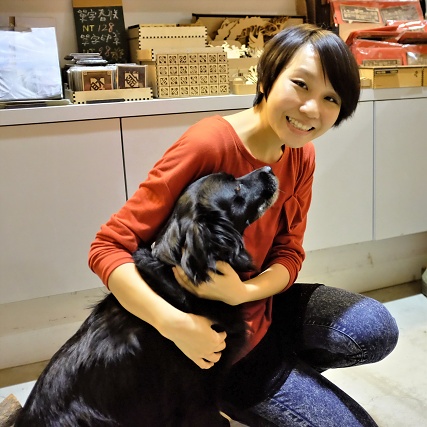
Bali: Midori from Frog Café for cyclists
In the evening, I was visited by Midori's brother who brought me a bag of food. I did not accept anything, except a small protective talisman which I could not refuse. Great boy, we had a nice chat.
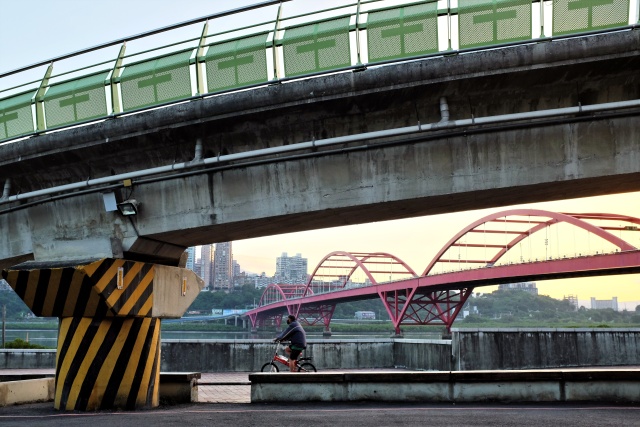
Bali: Guandu Bridge over Tamsui River

Bali: Coastal park
The following morning was easy. The bike path leading along the Tamsui River started in front of the Café. I crossed the river on Guandu Bridge, everything was fine, except for my rumbling stomach which was demanding its portion of calories. I ordered two meals in a 7-Eleven and, although my tablemate laughed at me, I felt as if I could eat a third portion too. I headed towards the northernmost part of Taiwan on Road 2 and discovered a Bike Way sign, which I double-checked in the brochure from the Airport, and then followed it.
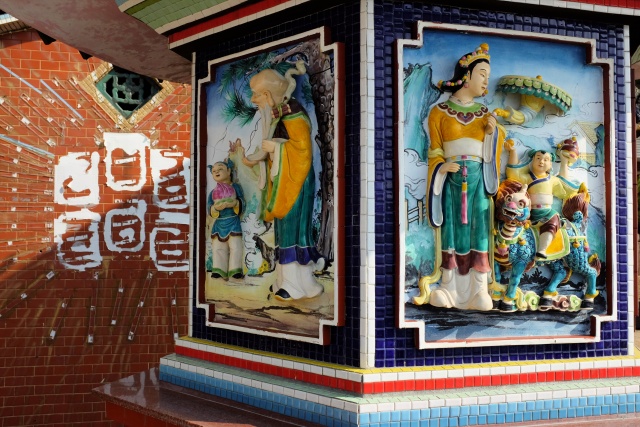
Tamsui: Riverside chapel
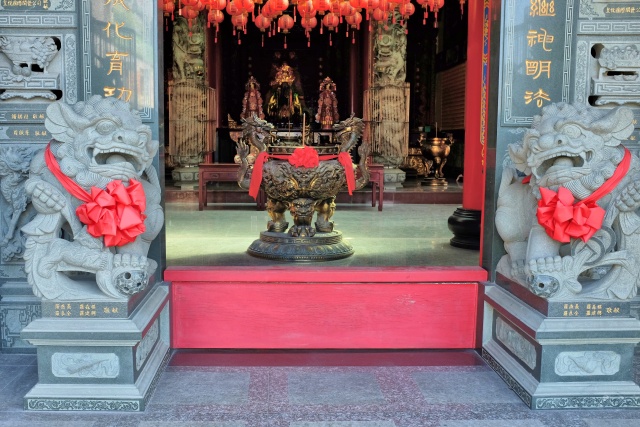
Sanzhi: Church portal
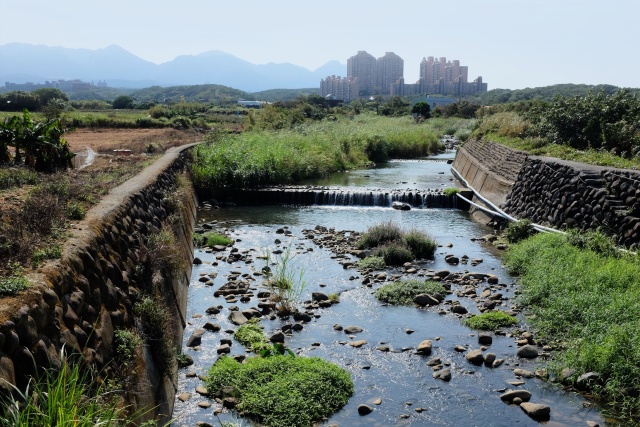
Sanzhi: Creek
The Temple of the Eight Immortals was still fine, but after that, it was worthless. The cycling path was to lead over a wooden trail through a swamp, but it was closed due to repair work. I returned to Road 2. In Shimen I was attacked by hunger again. I stopped at a small packed restaurant and ordered soup with big pieces of tofu. I had not yet dipped my chopsticks into it when some rather tipsy men from the next table started chatting to me. They had at least 15 empty beer bottles among the three of them and were in great spirits (at 12:30, I should mention). They thought my soup was too small, so they passed a bowl of calamari and some innards (probably liver) in slices to my table. And they taught me to eat it – which sauce or paste and how much to dip a particular morsel into. It was a good thing that I manage well with chopsticks, otherwise it would have been quite embarrassing.
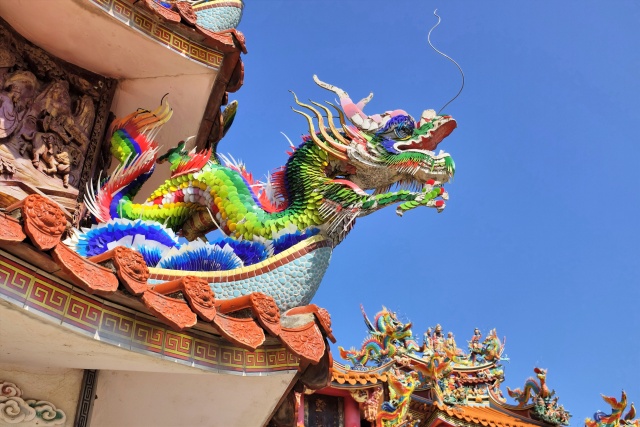
Sanzhi: Roof detail of Eight Immortals Temple
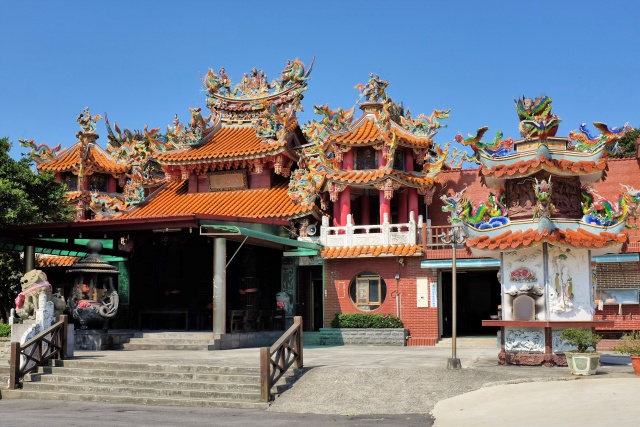
Sanzhi: Eight Immortals Temple
The tunnel on Road 2 did not allow cyclists through it, they had to cycle around over Yehliu Geopark. Thanks for that! Picturesque coastline, bizarre rock formations and a ship from Hamburg in the distance.
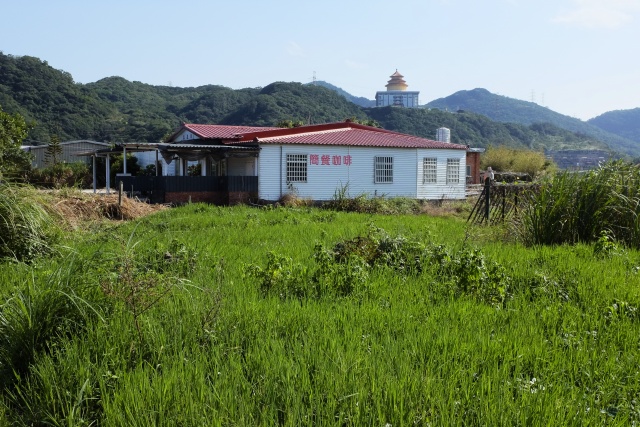
Wanli: Scenery
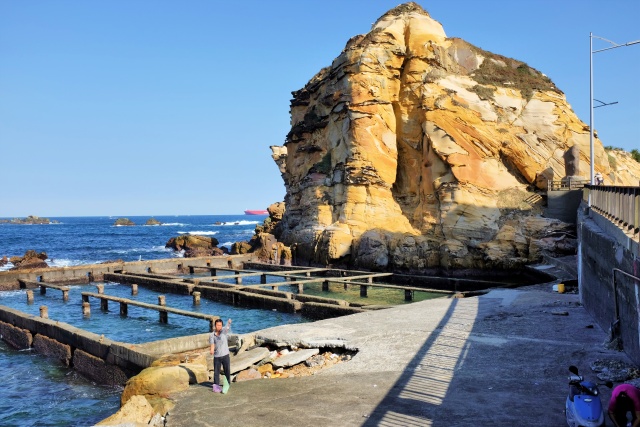
Yeliu: Picturesque rocks

Yeliu: Rocky coast
Keelung City
Next was Keelung City, crammed with people. I did not want to miss out on the renowned food sold at the Night Market and stopped at a slightly shabby hotel in the center, which charged about 800 CZK ($40) for a room. It was just fine, clean, WiFi and a spacious room. I checked out the two local famous Temples, without understanding why they were so famous. The market, however, did not let me down and I ate my fill until I was fit to burst.
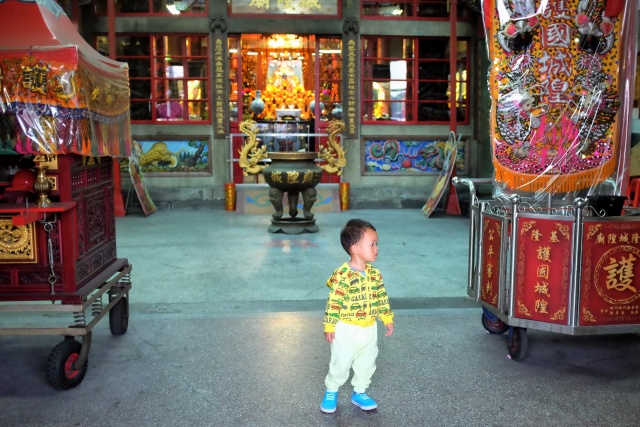
Keelung: Searching
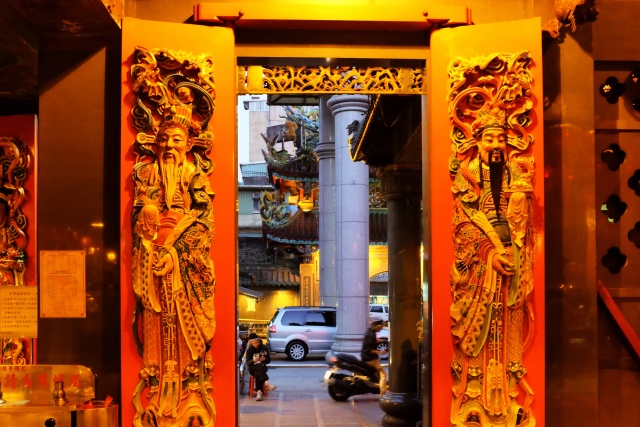
Keelung: Interior decoration of entrance portal
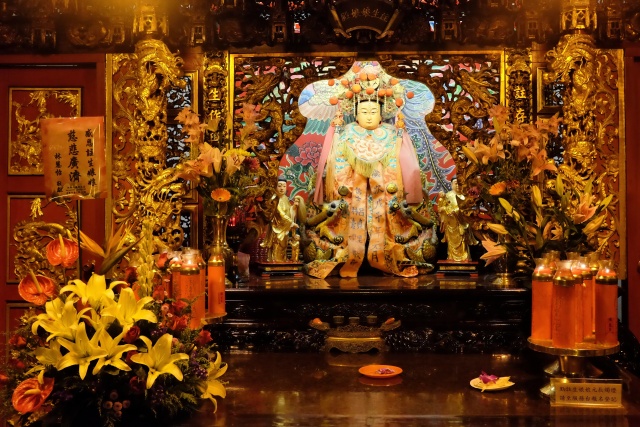
Keelung: Side altar
After the grandiose dinner for a minimal price, I did not feel a twinge of hunger the following morning. I went right into, for us, unthinkably busy and disorganized traffic, on an empty stomach. Masses of scooters were edging their way among the cars and I was in between them, yet with more limited maneuverable possibilities. It was impressive how well the locals on scooters and in cars managed all those zig-zag maneuvers, diversions, shortcuts and crossings. The only advice for such chaotic traffic conditions: act predictably, no sudden change of direction, be persistent. Others will avoid you or will stop, they are used to that.
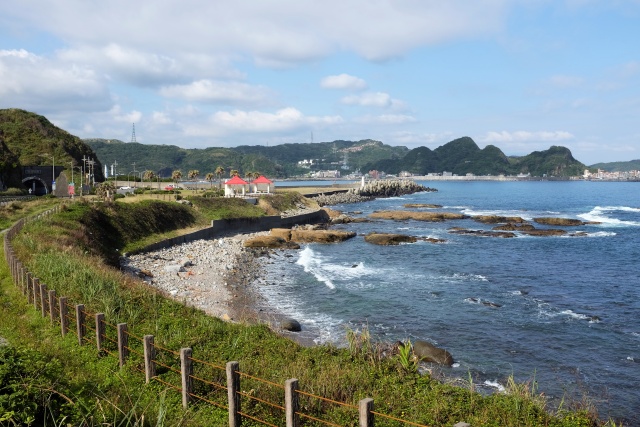
Ruibin: Coast
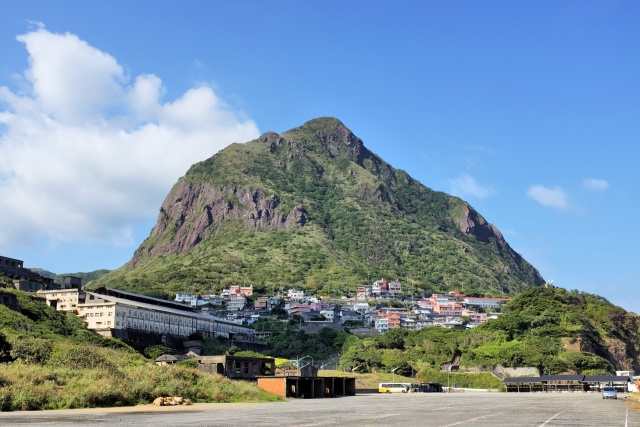
Ruibin: Hills near the coast
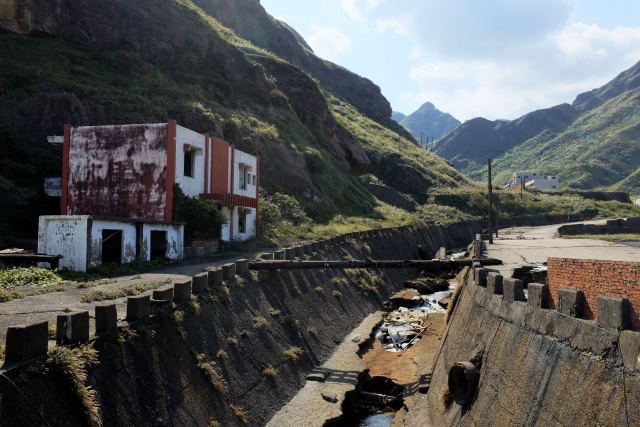
Ruibin: Mountain riverbed
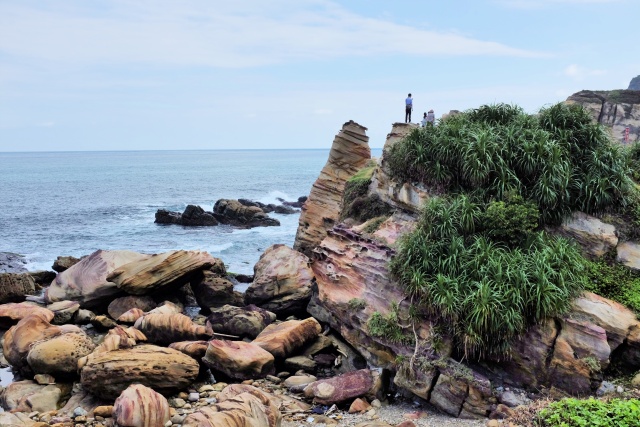
Bitou: Nanya Peculiar Stone
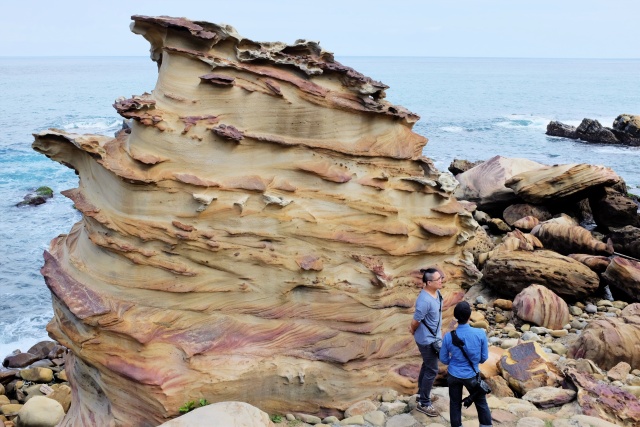
Bitou: Nanya Peculiar Stone
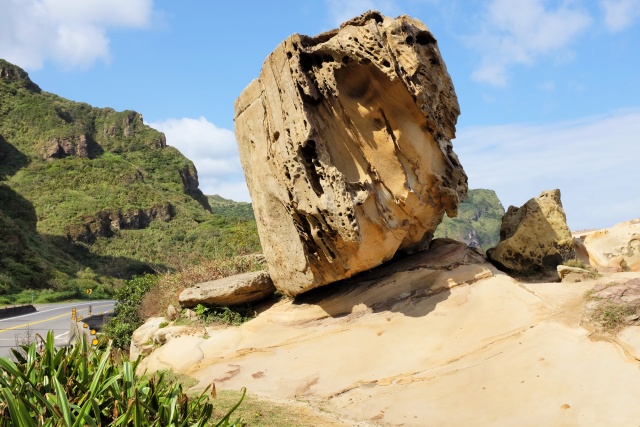
Bitou: Nanya Peculiar Stone
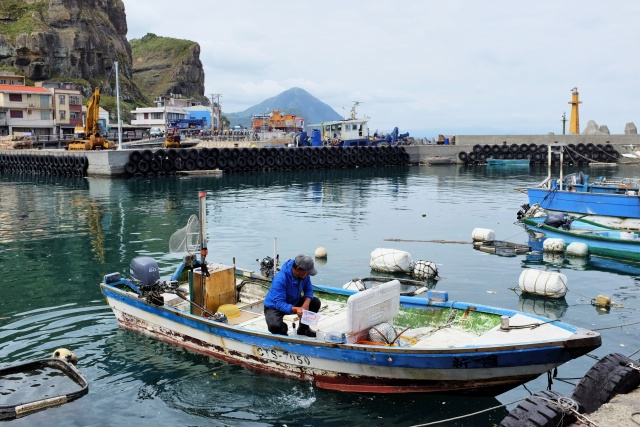
Bitou: Harbor

Bitou: Harbor
After the first 38 km, I ate in a small pub and then quickly went to a nearby 7-Eleven to fill myself up properly. Road 2 was pleasant, a reasonably wide lane and a wind from behind. The weather started changing and the forecast claimed it would rain for several days in the northern part of the island. It was a good thing that I was cycling southwards, I comforted myself, hopefully I would cycle away from it. However, the weather changes occurred very rapidly, clouds quickly covered the sky and it was only a matter of time before rain would fall. Luckily it did not and, thanks to the cloudy sky, I could enjoy perfect cycling weather.
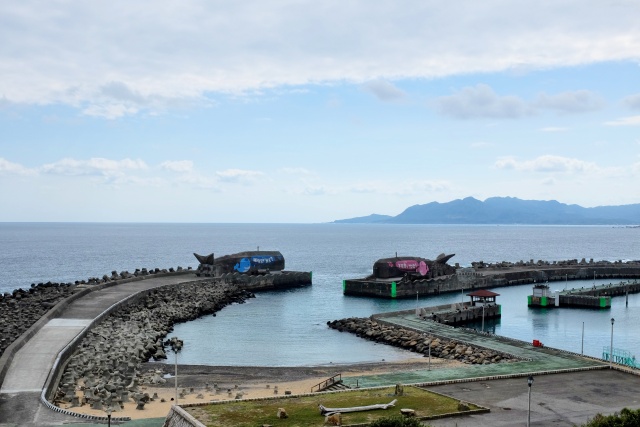
Longdong: Whales
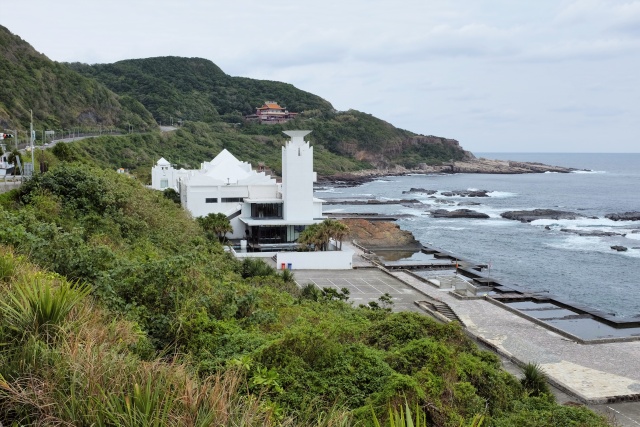
Longdong: Marina
Out of Fulong I saw a sign pointing to a bike path, yet after the previous day's experience, I hesitated. First I cycled to an Info Center, got a map, all the paths were free of obstructions. I noted a shortcut crossing Road 2 via a former railway tunnel, The old Caolin Tunnel. This was a tunnel open only to cyclists and offered 2.2 km of pure cycling joy.

Fulong: Exit from cyclists' tunnel (Old Caoling Tunnel)
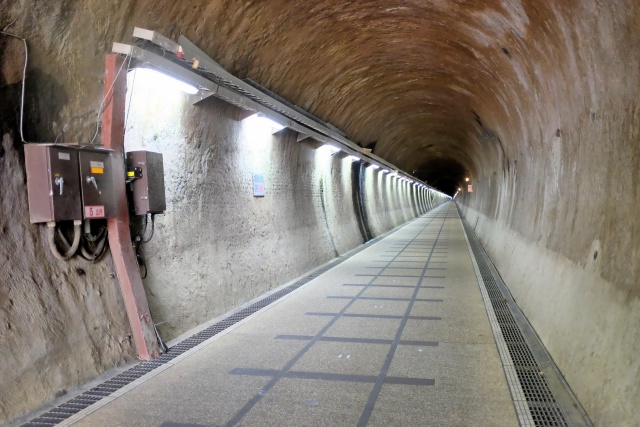
Fulong: Old Caoling Tunnel, originally for trains, now for cyclists
Then I checked the impressive Tian-gong Temple in Dali and that is where the joy ended. After that, I cycled through flat and boring landscape, which needed to be crossed – the fresh breeze blowing from behind helped me with this.
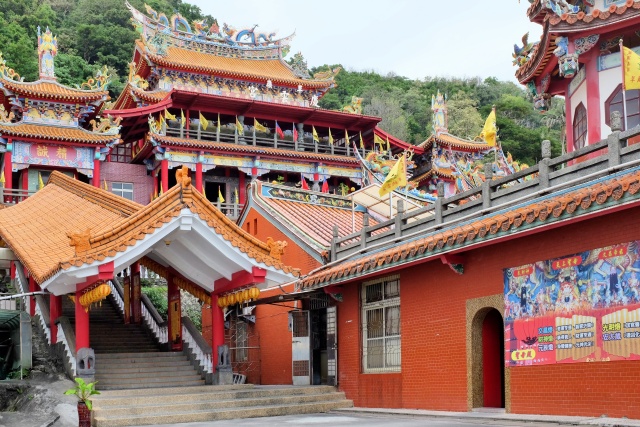
Dali: Tian-Gong Temple

Dali: Lion at the entrance of Tian-Gong Temple
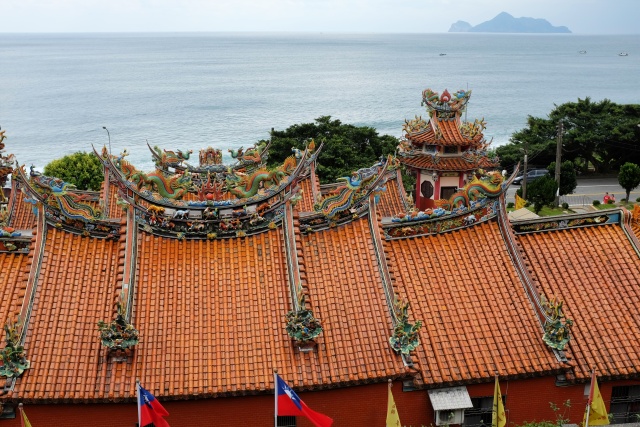
Dali: Roof of Tian-Gong Temple
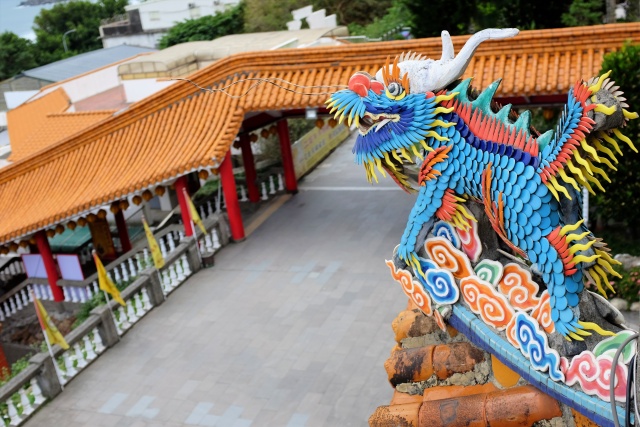
Dali: Ornate dragon on roof of Tian-Gong Temple
Suao Spa
I arrived at Suao quite early. Suao is famous for its cold mineral springs (21 degrees Celsius). The rain was approaching, so the right choice of a camping spot was important. I wanted to find something under a shelter. No luck in Suao, so I cycled to Nanfang-ao, 4 km away. I received a map in an Info Center, located a beach and went to explore it. The beach was suitable in every way: a restroom with running water and a sheltered pavilion nearby. I returned to Nanfang-ao, an unforgettable fishing town with two connected harbors. For the first time in Taiwan, I shopped in a self-service grocery store, where they accepted my credit card, then ate dinner at a local stall and headed off to my overnight accommodation.
I carried the bicycle and bags to an upper level above the restroom and, in a strong wind and with a struggle, pitched my tent. I was satisfied with how unnoticed and secretly I had managed to do this. Five local teenagers proved me wrong. They came to practice the ten English words they knew, smoked a cigarette, but since they did not like it, spat like lamas. I had to subdue them slightly, so that they would not burn down my tent in such a strong wind. It was not much fun, either for them or for me, so they left after about 10 minutes. Then I was left in peace for the whole night and did not even notice the heavy rainfall.
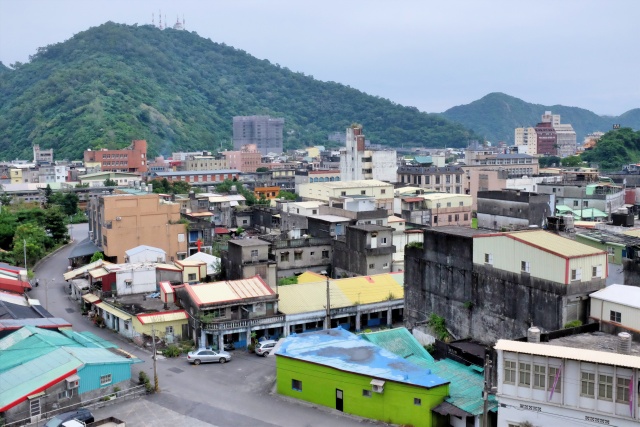
Suao: City vista
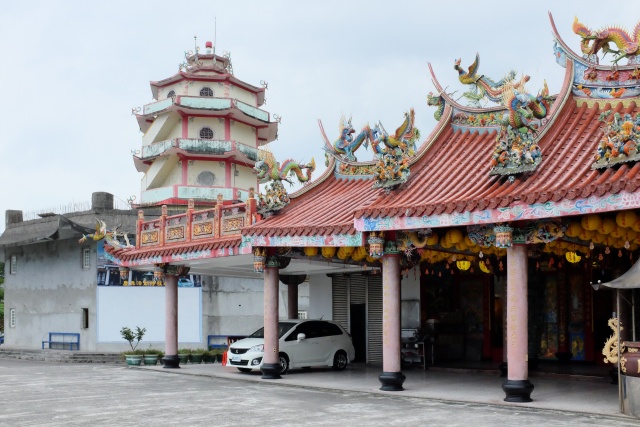
Suao: Monastery
The restroom cleaner was an early bird, starting work at 05:00 already, right on the floor above the restroom where I was sleeping. I got up at 05:30, cycled to enjoy the beach and harbors and then to enjoy a proper breakfast at a 7-Eleven. I enjoyed viewing the Gold Mazu at Nan Tian Temple, which I, disinterested, had cycled past three times the previous evening. The biggest attraction was the 200 kg Golden Buddha statue. I wanted to check out the cold springs in Suao, but it was still too early and the spa was closed. Then I had an acute need of a toilet and finally found refuge at a local railway station, even though only a local version of a Turkish toilet was available.
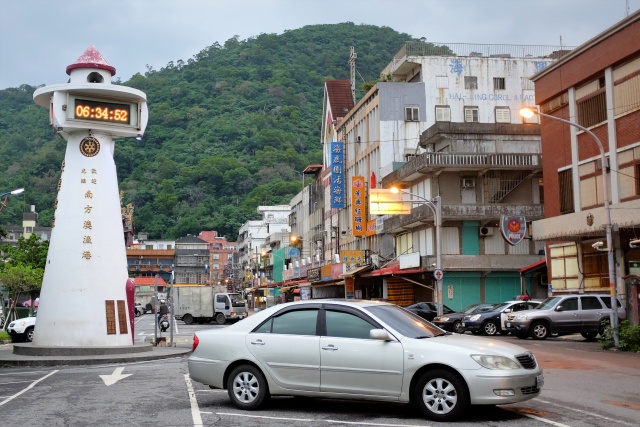
Nafangano: By 06:30 I was already wide awake
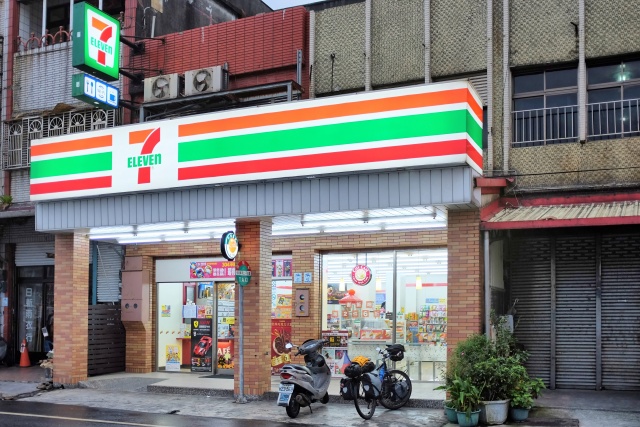
Nafangano: Hearty breakfast in 7-Eleven
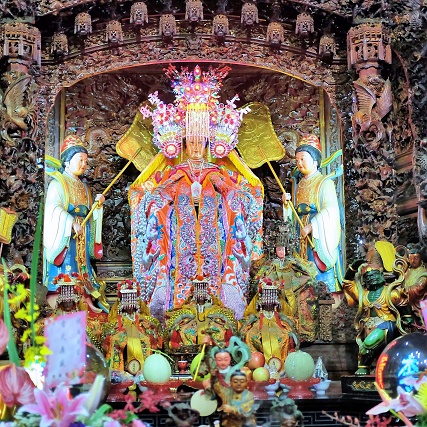
Nafangano: Golden Mazuch in Nantial Temple – 200 kg golden Buddha
Dangerous Section
Then it started. I had already been warned about it at Frog Café: between Suao and Taroko I would cycle on the very hilly, dangerous Road 9. It was not possible to bypass it and one needed to survive the danger. The biggest problem was the dense truck traffic on this narrow hilly road. The local specialty, which I had witnessed a few years back in Japan already, were the open rainwater drains, 30 cm wide and more than 50 cm deep. Really challenging: I sweated uphill in a very low gear, no side lane and between the white line and the drains there were only 20 cm. The truck drivers thought it was enough space for me, so they did not adjust their driving for it, but they did not have much extra space either. I need to say that they are used to cyclists there and try everything they can not to kill them. However, there were situations where I had to yield to the truck tires beside me and balance on the edge of a drain. It was after a rain, a little slippery, in other words, like cycling on a thin cooked noodle, heavy stuff!
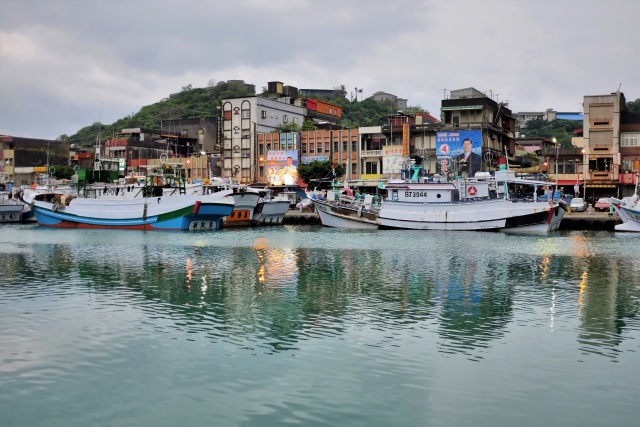
Nafangano: Second harbor
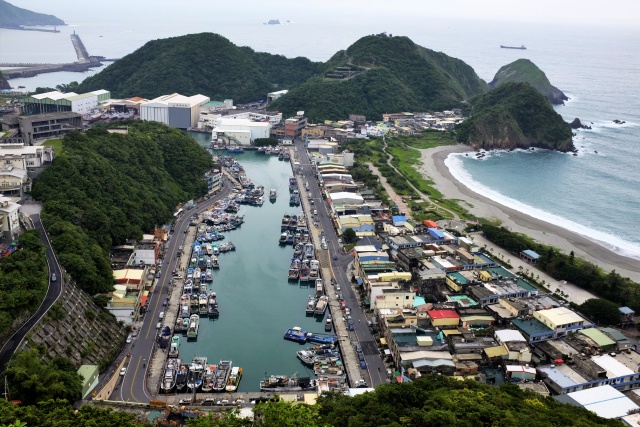
Nafangano: View of third harbor and Neipi Beach where I spent the night (blue roof, bottom right)
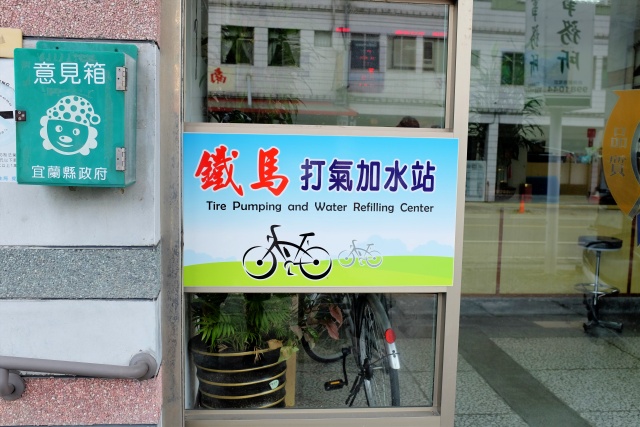
Nanao: Here they know what cyclists need, providing both pump and beverages
The most difficult part was the first section to Nanao, a true horror, where I had to push the bicycle for about 300 meters for safety reasons, or I would have fallen off or been smashed up. The section to Aohua was better, or I had got used to it.
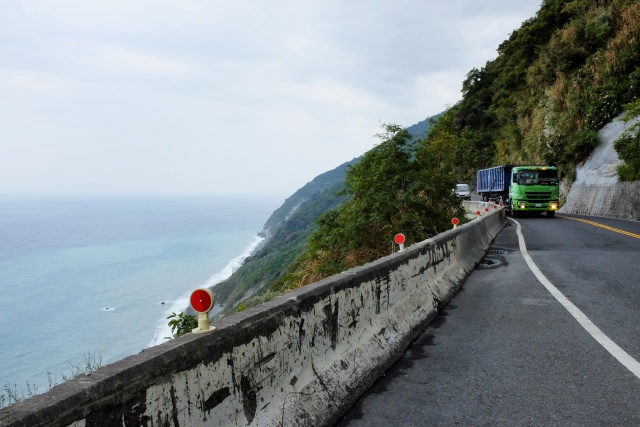
Near Nanao: Road 9
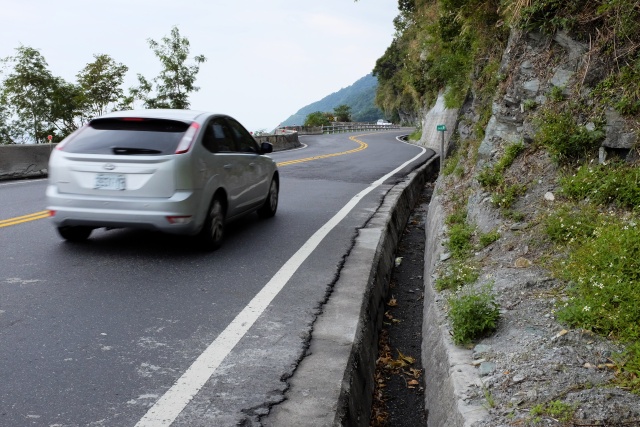
Near Nanao: Cyclists have 25 cm for their bikes; between the white line and drainage ditch
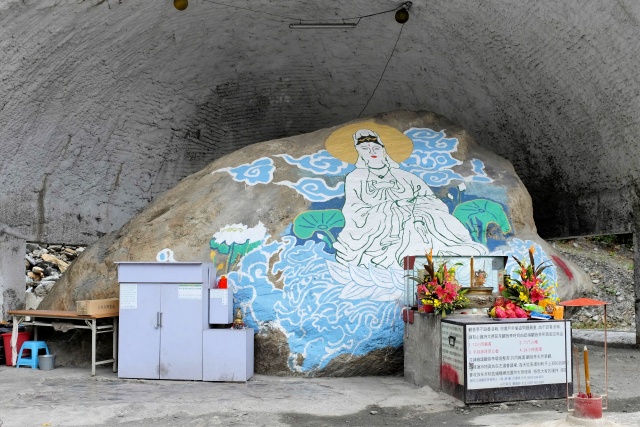
Near Gufeng: Convenient rock converted into a small shrine
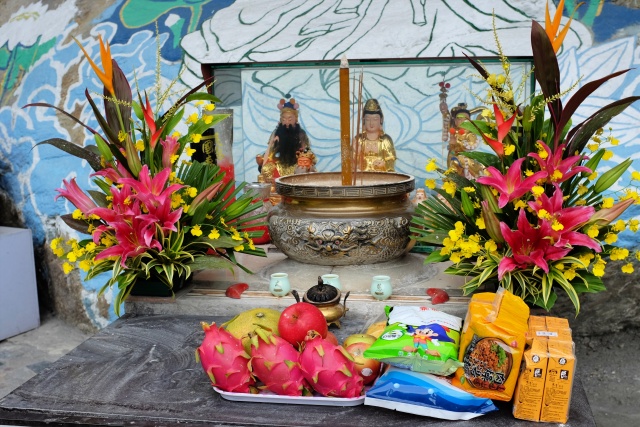
Near Gufeng: Sacrificial gifts in rock shrine
Tunnel Insecurity
The tunnel agony started after the peaceful 6 km to Heping. Road 9 went through a series of connecting tunnels, together 20 km long. They were quite old and I had the feeling that I was cycling though deep mines. Narrow dark holes, the stench of exhaust fumes, and a lot of stirred up dust got into my eyes. What's more, incredibly, an unexpected sign forbidding cycling in tunnels appeared. But there was no other way. The sign had a table in Chinese under it, I read through it thoroughly and decided to ignore the sign totally. The Police car which overtook me did not signal anything to me and finally my right to cycle there was confirmed when I came across a group of cyclists riding through those "forbidden" tunnels in the opposite direction.
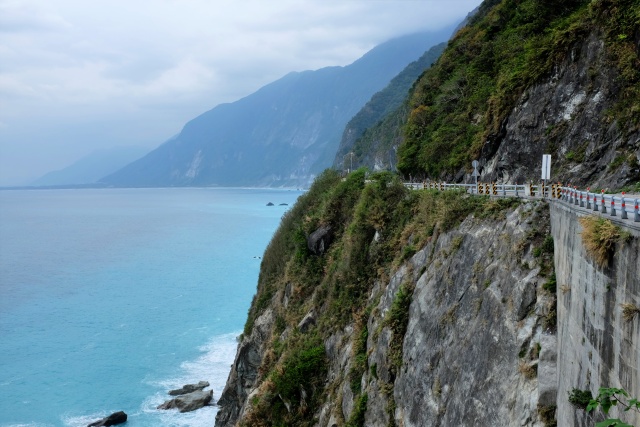
Near Heping: Road 9 on cliffside above the sea
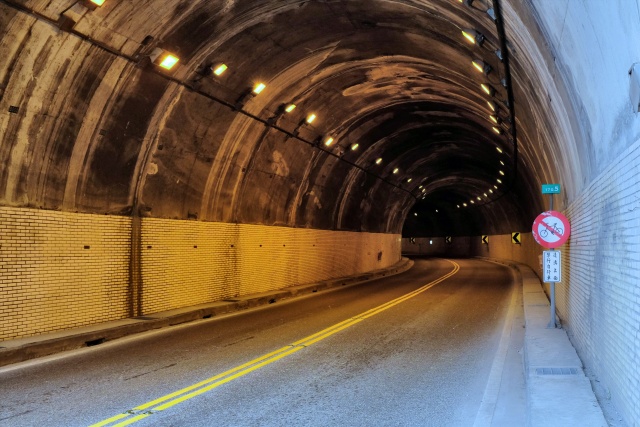
Heren: Confusing sign in the tunnel, prohibiting entry to bikes, but with sub-text adding clarification; I took no notice, there was no other route
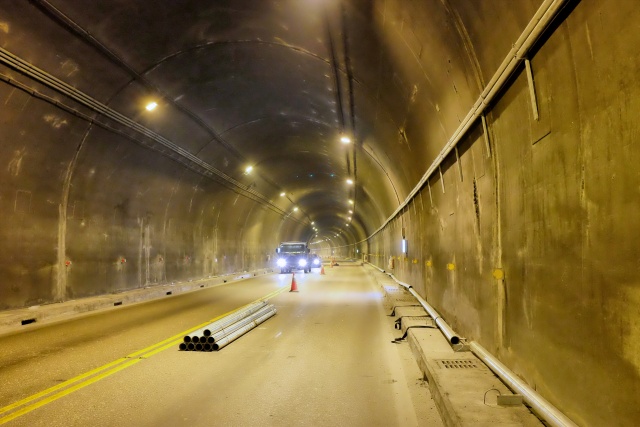
Near Heren: I enjoyed this tunnel – half was closed for repair, so I could cycle through it exclusively
Taroko National Park
The entry point to Taroko NP was the town of the same name. I arrived there already before 16:00 and asked at an Info Center how close the nearest campsite was. It was 15 km away, across hilly terrain. It was not possible to camp at the Info Center — a pity, as it would have been an ideal spot. However, a ranger coming out after me, stopped me and said I should return after dusk and pitch my tent wherever I liked. He would talk to the guard and ask him not to bother me. And this is also what happened. Apart from me, there were other people also sleeping over in their cars, who were loudly and without any cares enjoying an evening picnic. So the initial prohibition of camping there was not as strict as it seemed.
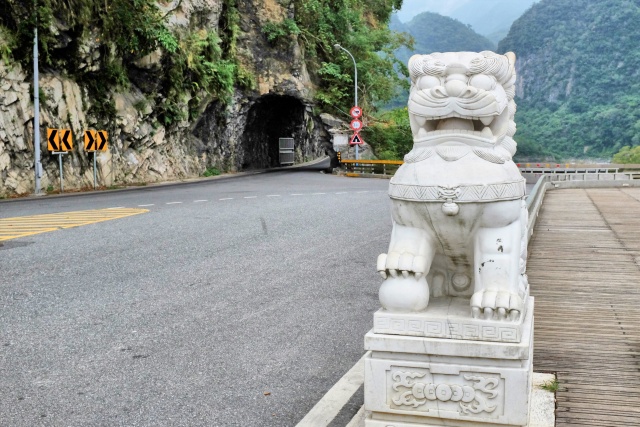
Taroko: Lion guarding Taroko National Park entrance
I cooked breakfast. They sold an American instant oatmeal there, which forced me to buy a gas canister and start cooking again. I did not spend too much time on it and arrived in the Park quite early; the masses of tourist buses arrived only around noon. The road gently and continuously ascended, but so mildly that it did not require an enormous effort. I cycled 18 km through the Park all the way to Tianxiang, where a renowned pagoda was located and then returned the same way. Half of the route consisted of tunnels, half-tunnels (one side of the tunnel was open, supported by pillars under crags carved into the rock.) Some tunnels were so crooked that I suspected they had not measured them correctly, so that the two sides dug from opposite ends did not meet. There were two campsites in the Park. One was free and the second one cost about 150 CZK ($7.50).
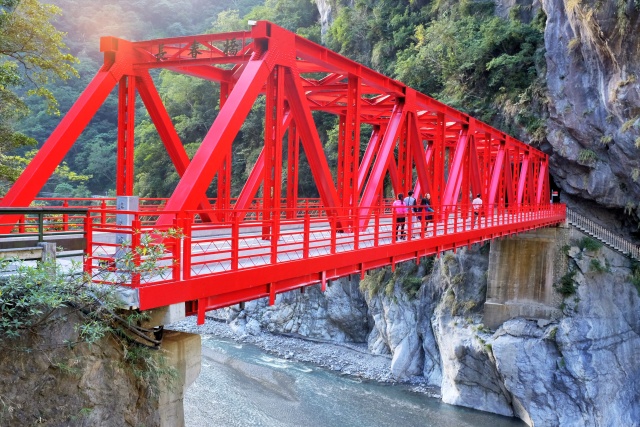
Taroko National Park: Bridge to Changuang Temple
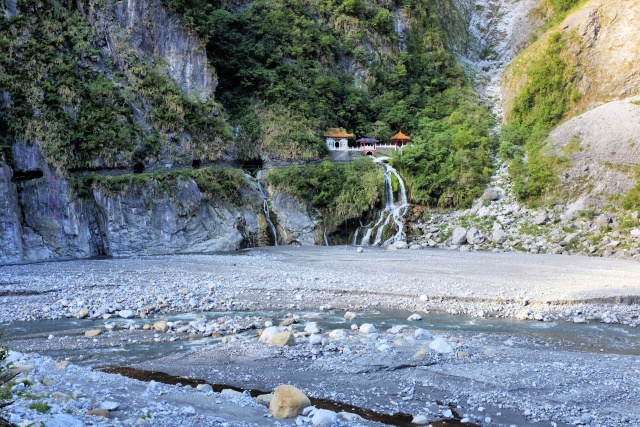
Taroko National Park: Changuang Temple
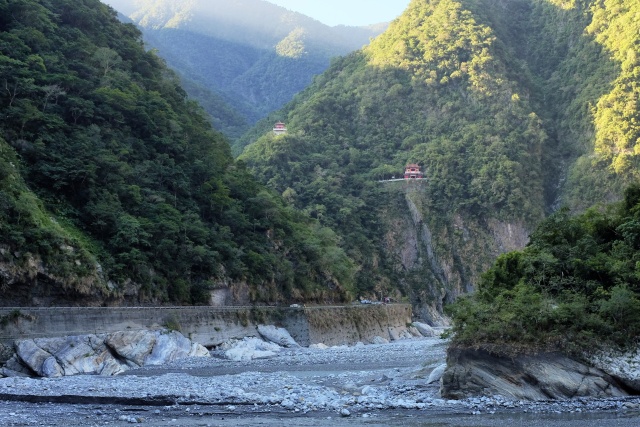
Taroko National Park: Monasteries high on canyon slopes
The road followed the river flowing at the bottom of a deep canyon among predominantly limestone rocks. Thanks to this geology, Taiwan became the world's biggest marble producer, as I read somewhere. Apart from the canyon, there were also several accessible caves, temples and many hiking paths. Some of them could only be entered with a permit and the rangers checked that people returned from them.
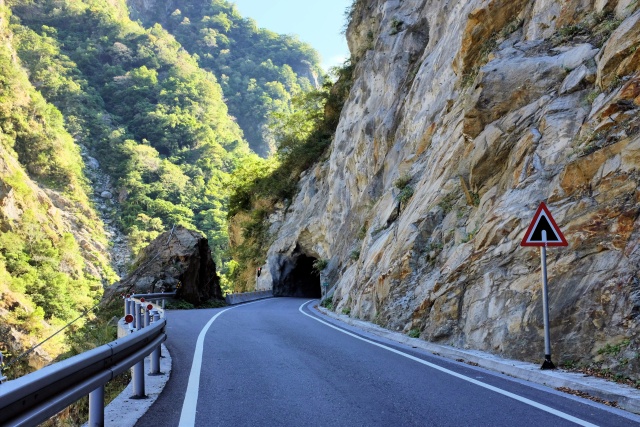
Taroko National Park: The road led through many tunnels

Taroko National Park: Tunnel walls were only roughly machined

Taroko National Park: Massive canyon rocks

Taroko National Park: Suspension bridge to Yanzikou Trail
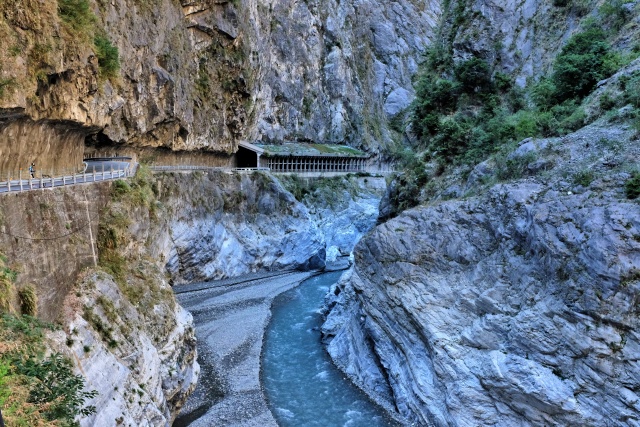
Taroko National Park: Road carved through rock
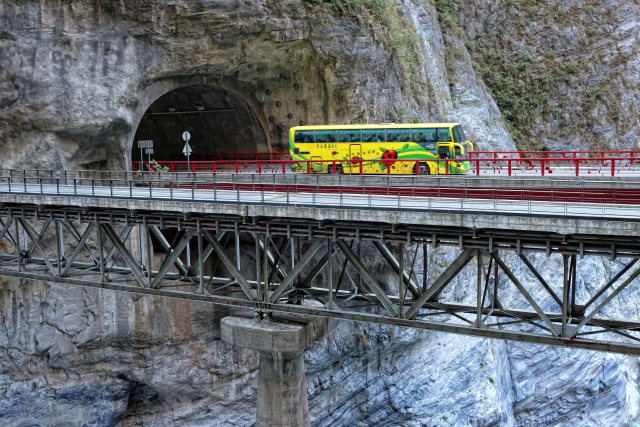
Taroko National Park: Jinheng Bridge
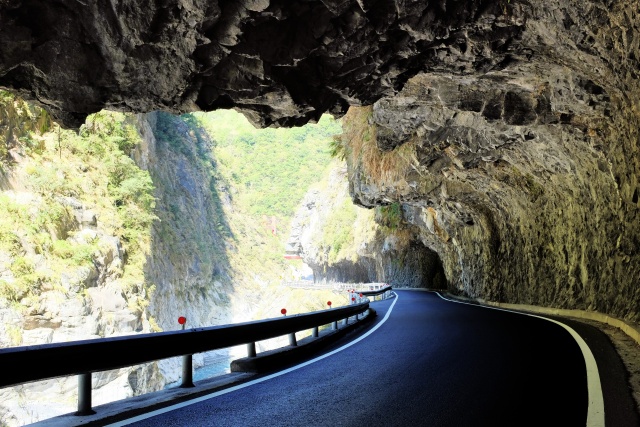
Taroko National Park: Road in Heliu region
Visiting the Park is definitely worthwhile. It is one of the biggest natural sites on the island.
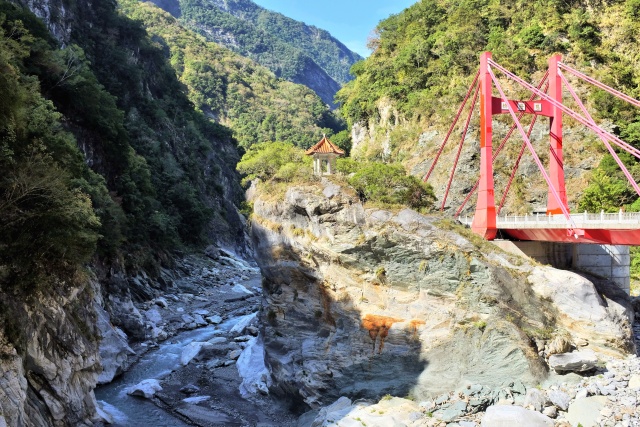
Taroko National Park: Cimu Bridge and pavilion on the rock
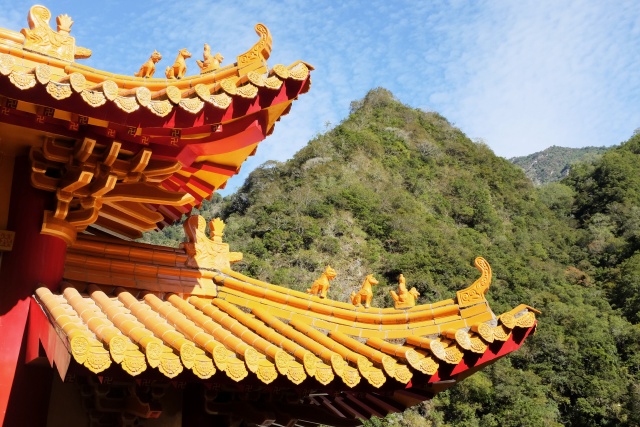
Taroko National Park - Tianxiang: Roof of entrance gate to monastery
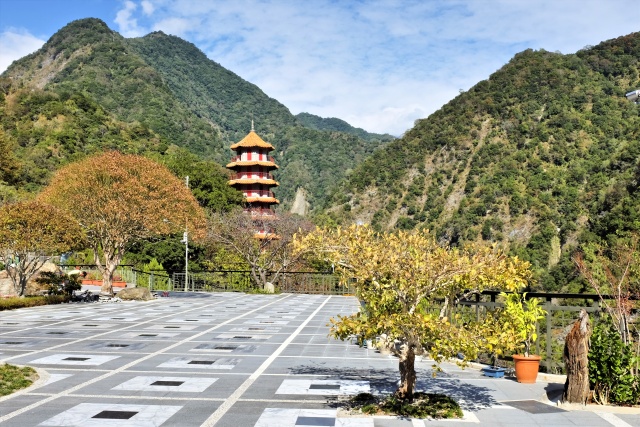
Taroko National Park - Tianxiang: Pagoda and courtyard of monastery
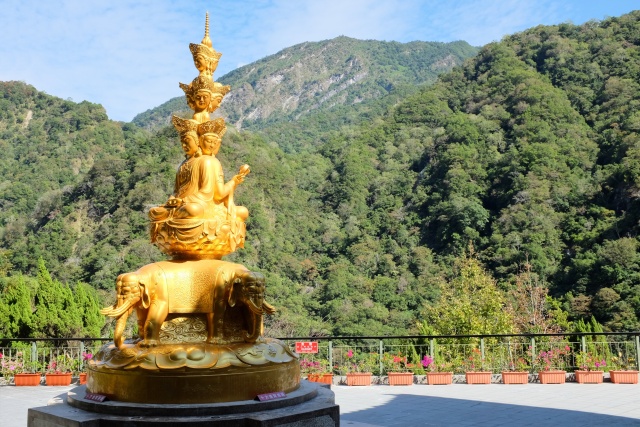
Taroko National Park - Tianxiang: Statue of goddess with heads facing in 10 directions

Taroko National Park - Tianxiang: Monastery interior
After the cycling adventure in the NP, the straight road with a wide side lane for bicycles and scooters and with the wind at the back felt quite boring. The first supermarket I found in Taiwan was in Hualien, a regional center. In Carrefour I purchased a good pastry of the European type and even American hard cheese. I ate the cheese for dinner with the pastries and once again it proved to be incompatible for local conditions. It resulted in a very runny consistency and the frequent need for a restroom. Stomach like water. I decided to skip cheese for the rest of the trip.
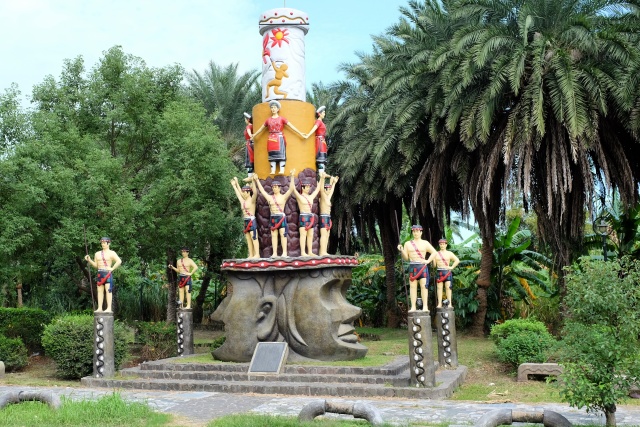
Hualien: Socrealistic-style monument
The idyll on the flat road lasted several more km after Hualien. Then a series of five tunnels followed, a total of 3.5 km in length. The tunnels were uphill with a maximum of 50 meters between them. It truly warmed me up. After the last one, I took off my cycle clothes and rode only in my t-shirt in the cool early evening.
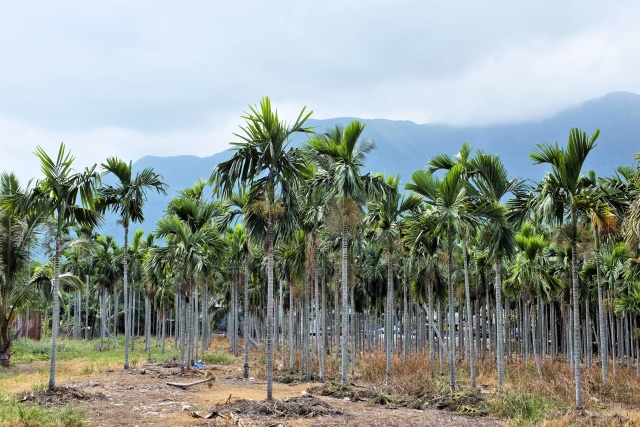
Hualien: Mountains shrouded in clouds
Night Move
The road turned away from the coast, ascending quite steeply and, although there were sites to pitch my tent on the way, they did not have any running water. In the end, I stopped in a valley with a pavilion and a nice small cut meadow. Evidently it was a public space, not private. The rain appeared to be approaching, which seemed to be more an everyday rule than an exception. I pitched my tent in the pavilion. Instead of washing, I used wet wipes and after dusk went into the tent and fell asleep (it was dark already by 17:40).
At 21:30 I was woken by a grandpa. I first thought that he was a homeless guy who wanted me to vacate the pavilion for him. He signaled repeatedly with his hands and feet that I could not sleep there. I thought it was strange, there was absolutely nobody around who could mind me being there. Finally we agreed in sign language that I would move my tent to the meadow. I expected him to make his bed in the pavilion himself, but he left with words of thanks (as he thought) by happily repeating "I am sorry."

Dongsing: Coastal villas
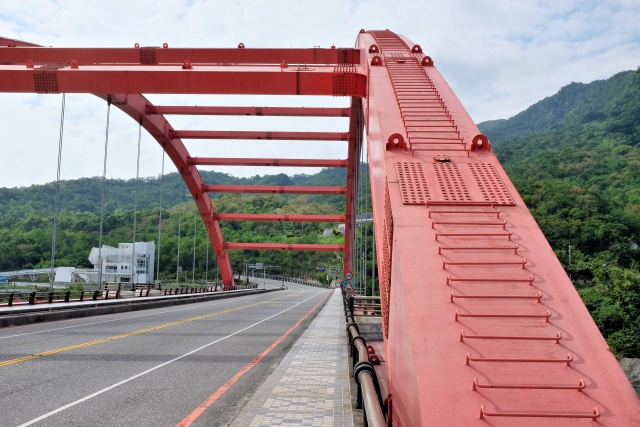
Changbin: Changbin Bridge
The following morning, after ascending for about 3 km, I reached an ideal "hotel stop": public restrooms, running water near a well-maintained meadow. My GPS was not aware of this place, otherwise I would have gone there already the night before. I had a wash, cooked some oatmeal, ate all the food remains purchased in Carrefour and was ready for the adventures of the new day.
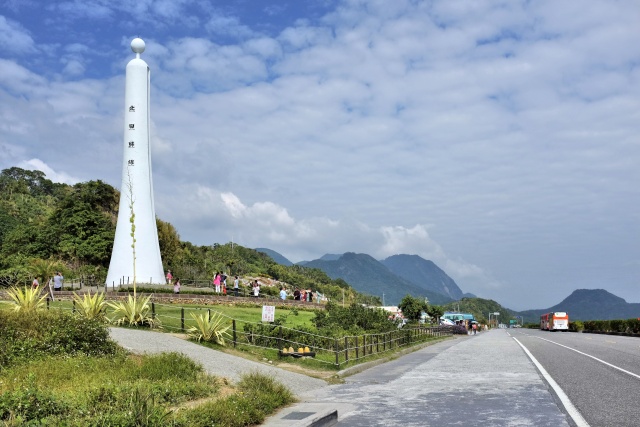
Changbin: The Tropic of Cancer is marked by this structure; I entered the tropics

Changbin: Old bridge
Baxian Cave
There were quite a lot of them. Already the rocky and rugged coast was enjoyable. Then I entered the tropics, which was indicated by a monument marking the Tropic of Cancer. The Baxian Caves, which were inhabited already in prehistoric times, were now literally "cluttered" with built-in Buddhist temples, decorated with pasteboard and gold colored foil. Although there were many tourists, only a few made their way up the steep steps to the upper caves. Naturally, I went up there, but it was not worth it, they were full of trash.
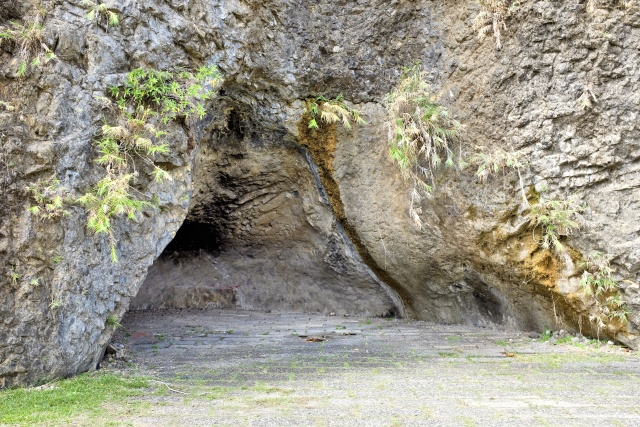
Baxian Caves: One of the few caves without a church
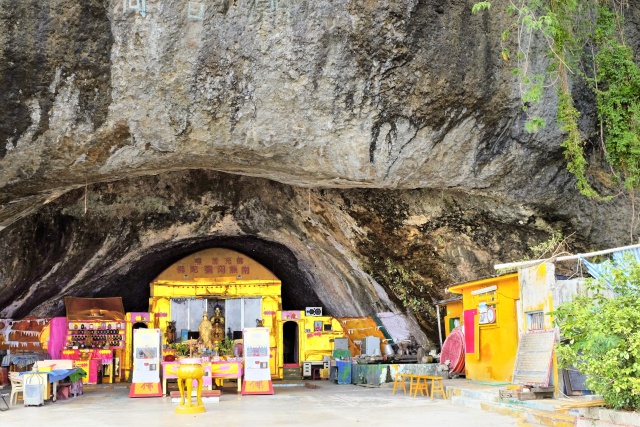
Baxian Caves: Church in cave
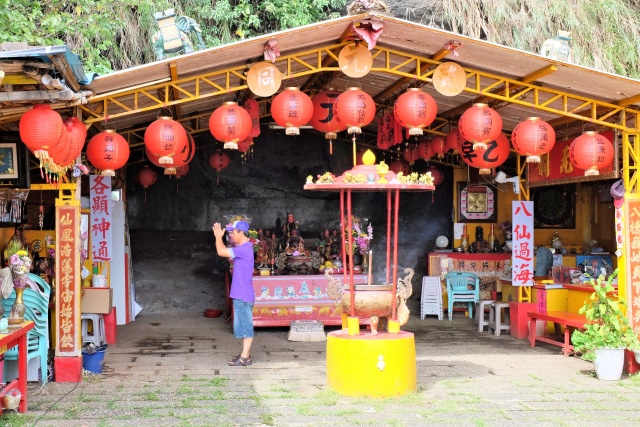
Baxian Caves: Young man worships in the upper cave after a strenuous ascent
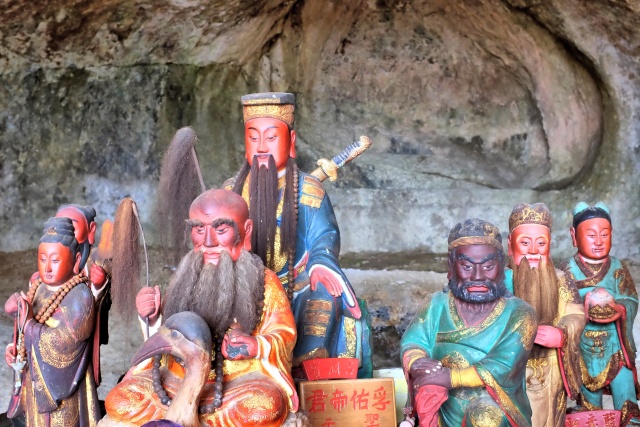
Baxian Caves: Detail of altar statues
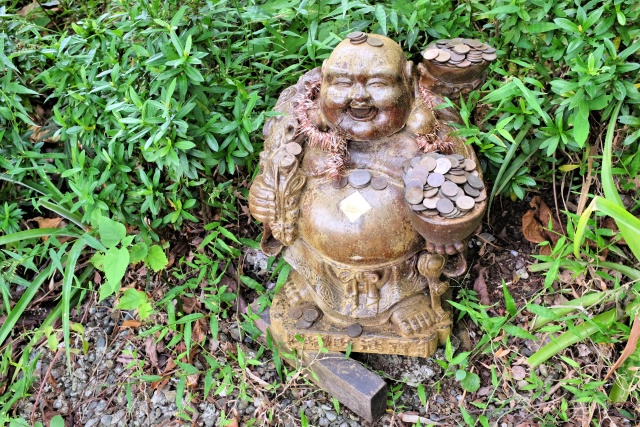
Baxian Caves: Laughing Buddha, money just pours in
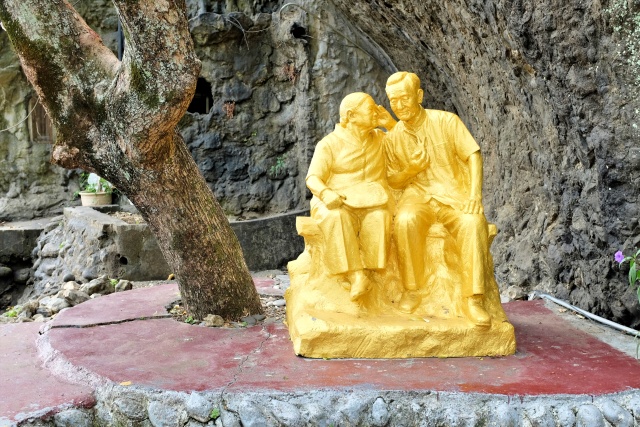
Baxian Caves: Golden oldsters
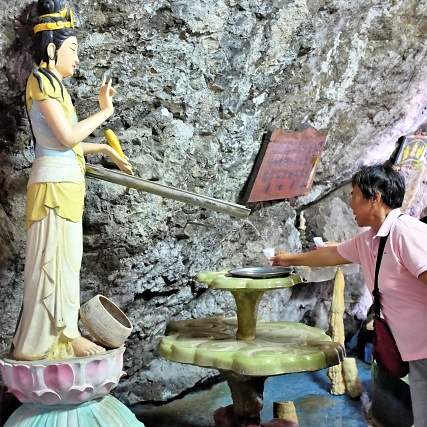
Baxian Caves: Statue with water, I drank from it too
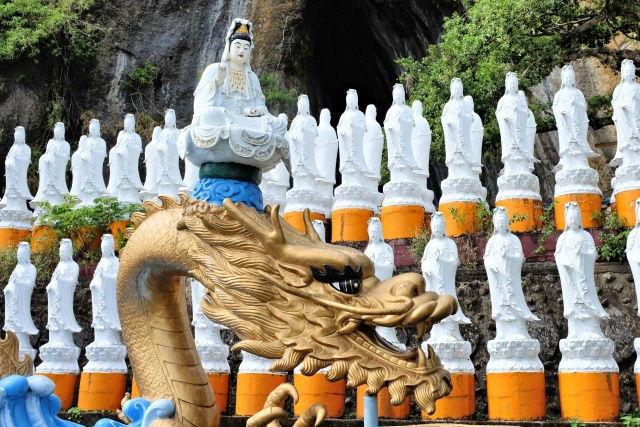
Baxian Caves: If it's kitsch, make it big
Despite the interesting site, I became very sleepy and freewheeled, with the wind from behind pushing me forwards. The wide side bike lane was safe, but I still had to concentrate, otherwise it could turn out badly. I tried solving it with food – noodle soup did not help, but the coffee in a can kicked in and brought me back to life.
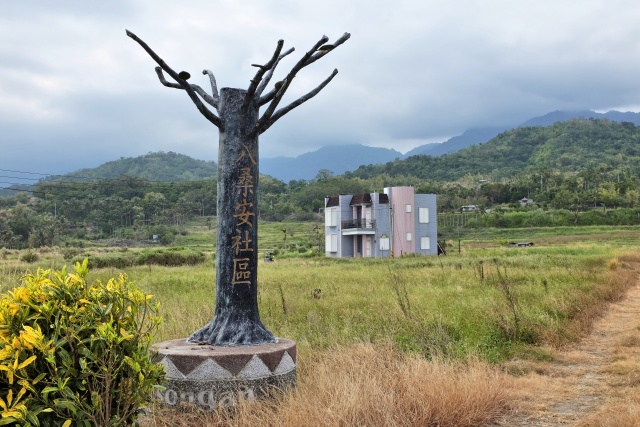
Baisangang: Artificial tree
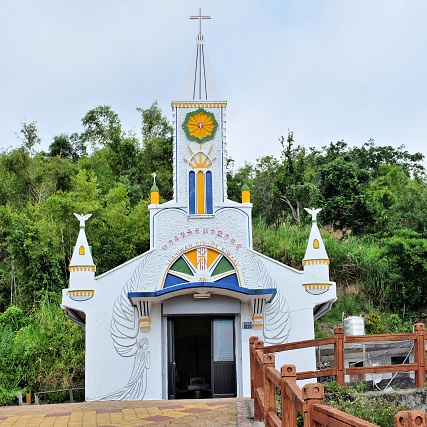
Yiwan: Christian church
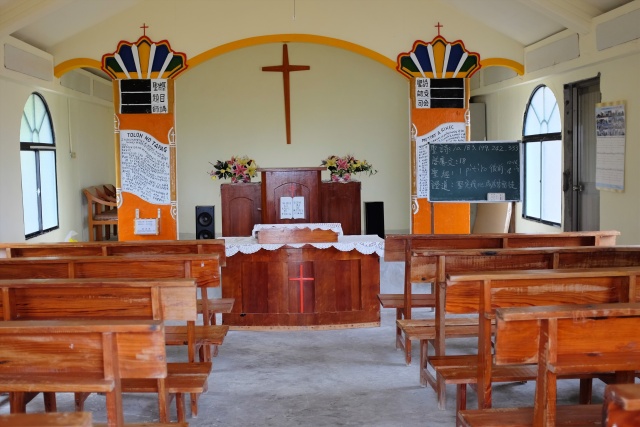
Yiwan: Interior of Christian church
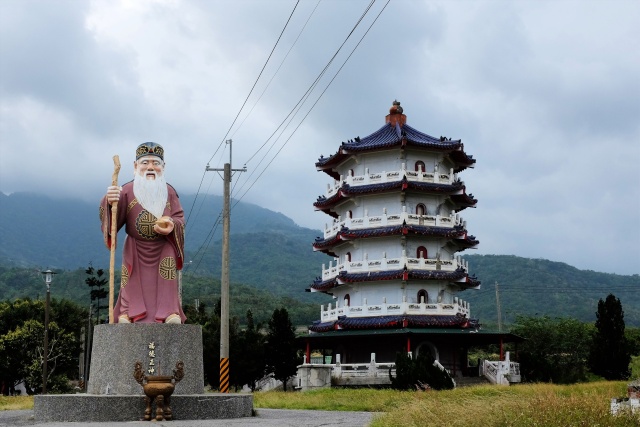
Chengong: Statue and pagoda
Sanxiantai
I arrived in Sanxiantai in the early afternoon. Sanxiantai is a pebble beach and an island with eroded rocks reached by a seven-arched bridge. I walked peacefully across the bridge and at the same time spotted a pavilion for sleeping on the beach. It had started to rain, so I would not have to drag a wet tent with me the next day. All the stores closed at dusk and the parking lot was empty. I sat working on my laptop in a sheltered area which functioned as an open-air restaurant.
Then I cycled to the pavilion to pitch my tent, but the wind was so strong that I could not manage it. If only I could have hammered in at least two pegs, I would have coped. But hammering them into concrete is really not an easy task. I returned to the restaurant and pitched my tent in a space between the tables and all was well.
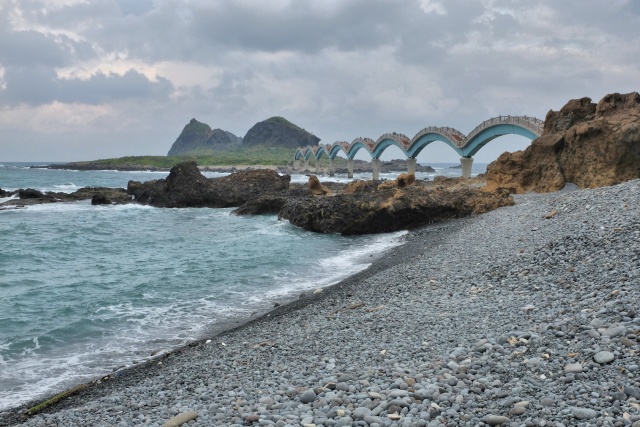
Sanxiantai: Pebble beach and footbridge to the island

Sanxiantai: Eroded rocks
I complemented the obligatory tea and oatmeal at the first 7-Eleven combini with coffee from a can and the local version of Korean fishcakes. The fishcakes were a bit bland though. The countryside was filled with blooming flowers and sunflowers, with palm trees in the background. The road was flat, a wide side lane, the wind at my back, no rain, what more was there for a cyclist to wish for?
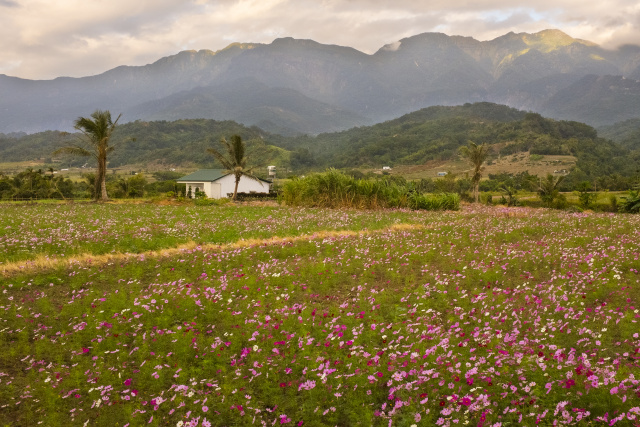
Chenggong: Flowers in the morning pleased me

Chenggong: Sunflowers against the light never disappoint

Chenggong: Breakfast at the usual enterprise
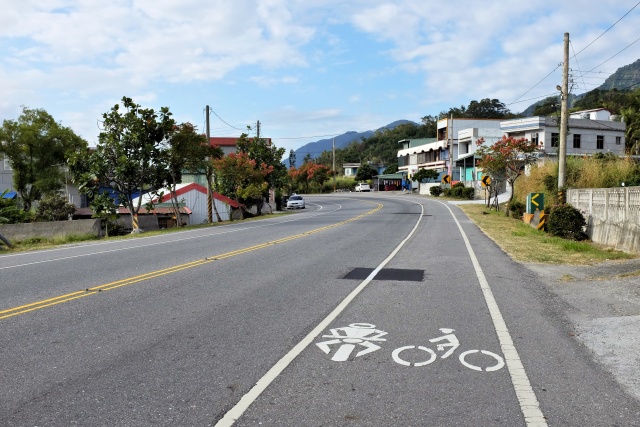
Chenggong: Convenient lane for bikes and scooters
And yet there was something that shocked me. A sign at the roadside offered a service for cyclists: water and pump. This service was offered by the local Police station and their services also included a photo of the cyclist and even a free campsite behind the Police station. I was really in shock.
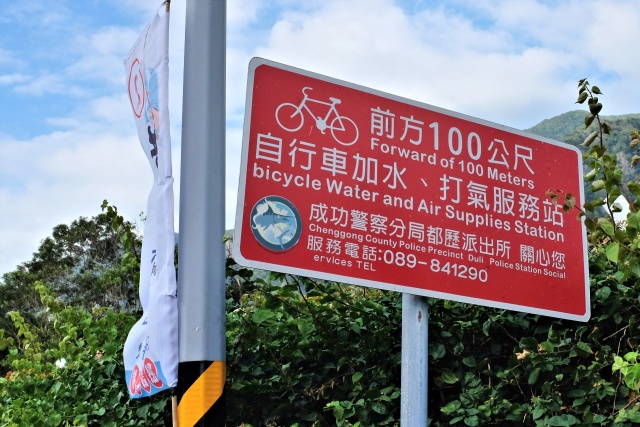
Chenggong: Signs indicating water and pump at Police station
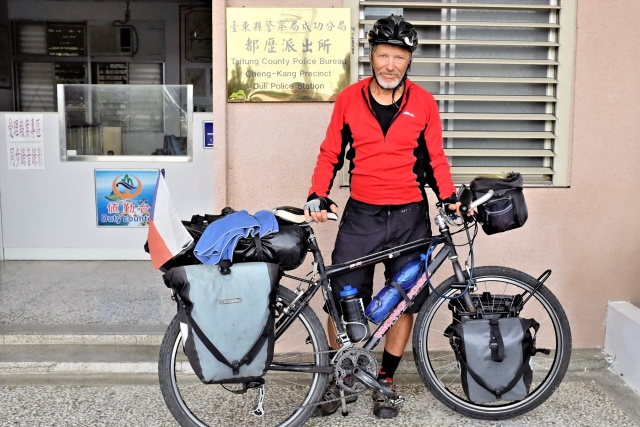
Chenggong: Photos taken by the Police outside their station, offering cyclists' services including free camping
Several natural places of interest were next. The first one was water running uphill— a narrow bed of a stream with water which evidently flowed uphill. Perfect illusion. I checked the angle of the water basin from the side through the level in my camera monitor. Of course, the water ran downhill, it was just an optical illusion, yet quite a convincing one! By the way, usually no entry fee was charged, instead the parking lot charged a fee – more expensive on bank holidays, cheaper on working days. Bicycle parking was free.
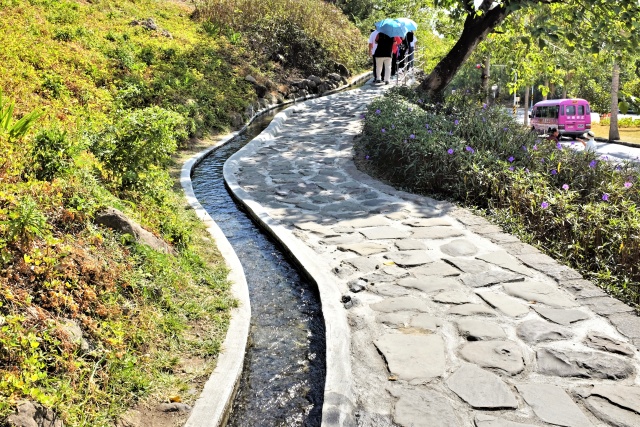
Jinzun: Water flowing uphill
Apart from a shrine on the coast, in Fushan there is also a path in the shallow sea, from which one can feed the fish. They are used to it and are plentiful. Among them I found my favorite jumping fish which can jump above the water level, even up to 2 meters high and then fall back flat on their sides.
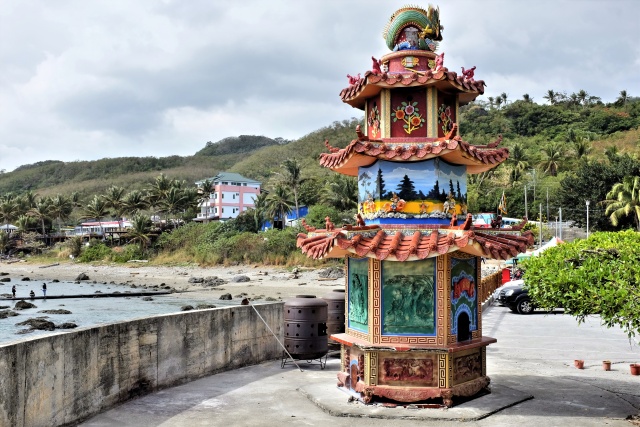
Fushan: Coastal shrine
The next site was the Xiaoyeliu rock formations. The same area had a free campsite. My favorite dumplings were served in a restaurant there, I could not skip those.
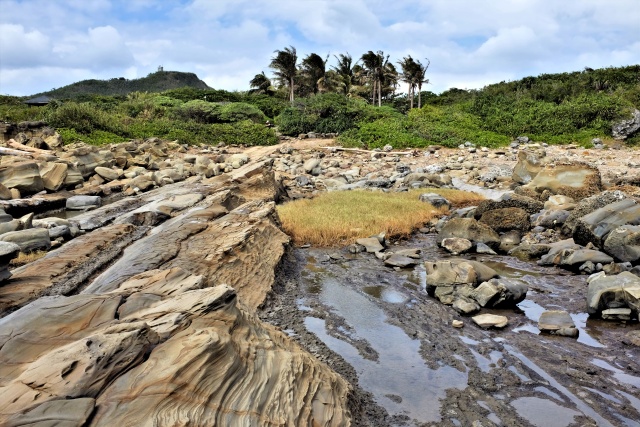
Xiaoyeliu: Rock formations
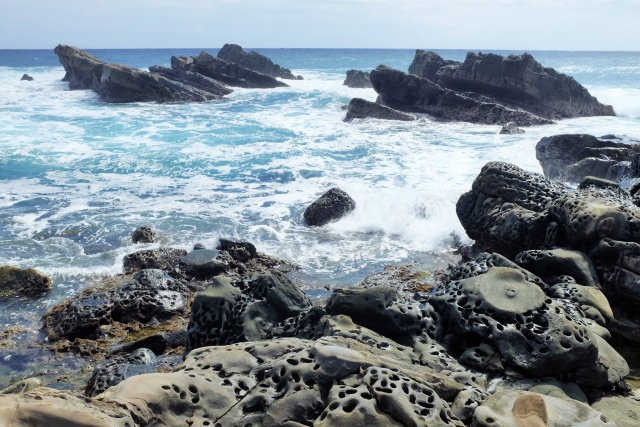
Xiaoyeliu: Rocks in the ocean
Then I pedaled to Taitung, where I needed to do my laundry and buy food. I knew the Tourist Info Center was located on the train station, which was atypically 6 km out of the center, not right in it as is usually the case. It was a bit out of the way for me, so I cycled the extra 15 km just to find out that the laundromat was somewhere in the city center. I thanked them nicely and cycled to the center. At a crossroads, I was searching for the direction on the GPS when a boy on a scooter stopped to help me. I told him I was looking for a laundromat and a supermarket. He took me to the laundromat and, on the way, pointed out the way to the local Carrefour.
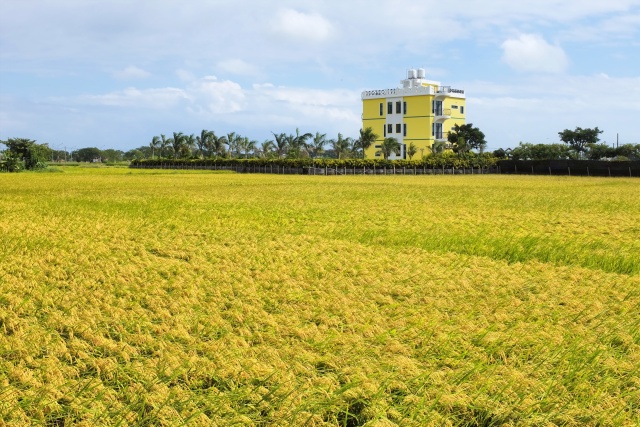
Taitung: Rice field
Washing - Washing
The self-service laundromat was occupied by a one-toothed granny, who had her scooter loaded with second-hand junk parked in front of the laundromat. She found it necessary to explain to me how to use the washer. She showed me how many coins to put in (it was written on the display) and forced me to repeat the Chinese numbers from 1 to 10. Failure to pronounce them correctly was uncompromisingly corrected. Meanwhile, I took out all my dirty clothes, took off everything which was possible to take off under the relevant conditions without breaking any code of conduct, and started my laundry. At the same time, I continued to receive Chinese lessons. The grandma had a good heart, she poured her own washing powder into the washer (even though I had bought some in the vending machine) and I had to stop her, or she might have poured in half a kg of it, that is how generous she was. She even tried giving me some coins, but I had enough. I wanted to photograph her, but she refused, saying that she did not have her teeth on her. So at least I took a quick photo of her in secret. I was relieved when she finally left on her boneshaker.
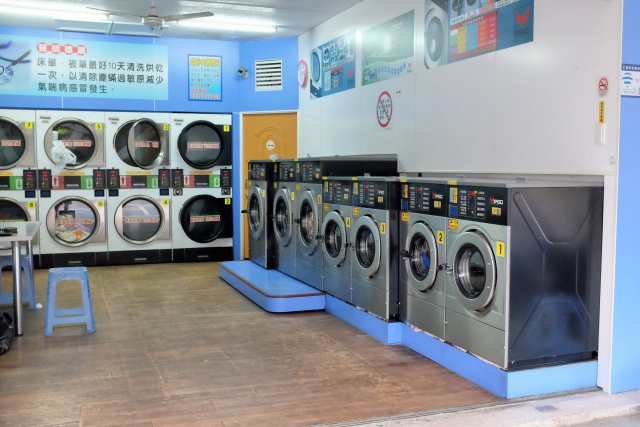
Taitung: Laundromat
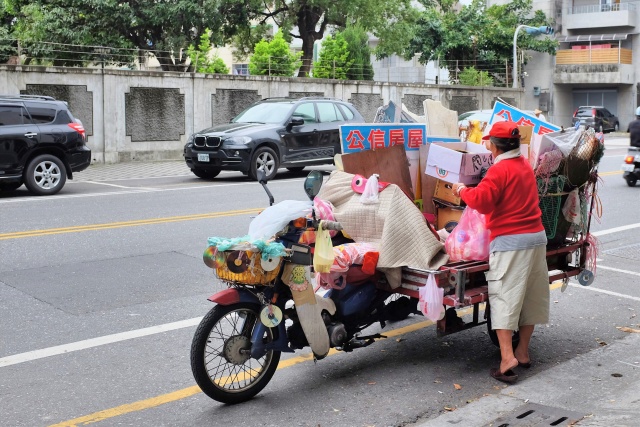
Taitung: Friend in laundromat excelled in second-hand goods
There was only one electric power plug and it was used by the washing powder vending machine. I disconnected it in order to charge my laptop, so I could at least edit photos that evening. The washing and drying proceeded without any further disturbance. Meanwhile the granny returned to collect her laundry and totally ignored me. As if I was not there. She must have been upset by my inability to learn Chinese. I quickly did some shopping in a supermarket, as I wanted to cycle few more km. I aimed for Zhiben Hot Springs, a popular spa about 15 km from Taitung.
This is my Sleeping Spot, you Moron!
As I approached the spa, a soft, all penetrating rain started. I delayed putting on my waterproof jacket and trousers. The road divided, one road led to the spa and the second one to the river. I figured that I had a better chance of finding a shelter for sleeping at the spa, where there should be a park. Success! I found a shelter with a restroom and running water 150 meters away. I sat down in the pavilion, but did not pitch the tent yet. A man on a scooter arrived, carrying a big plastic bag and ran up to the pavilion. He vehemently gesticulated that I should get out of there as he planned to sleep there. I smiled, shook my head, pointed at my chest and then at the floor – I will sleep here. He pointed into the distance, meaning that there was another pavilion where I should relocate to. I already knew that, but I also knew that there was a light there from the nearby building. So I generously gestured that he could relocate there himself. He stubbornly stood there, outside in the rain, I dry under the roof. Eventually, he started his scooter and left. The following morning, he passed by on his scooter, just when I was having my breakfast. He did not even wave at me, what a moron!
Dotted Road
I headed towards the southernmost corner of the island on Road 9. Road 26 from Daren along the coast had part of it marked with dots on the map. I figured that it was a section with an unpaved road. In reality, it was slightly different, the road suddenly ended and the dotted part was to be built in the near future. I returned to Daren and crossed to the western side of the island on Road 9. It was worthwhile. The first 12 km was a real uphill pedal and then a 20 km easy ride down.
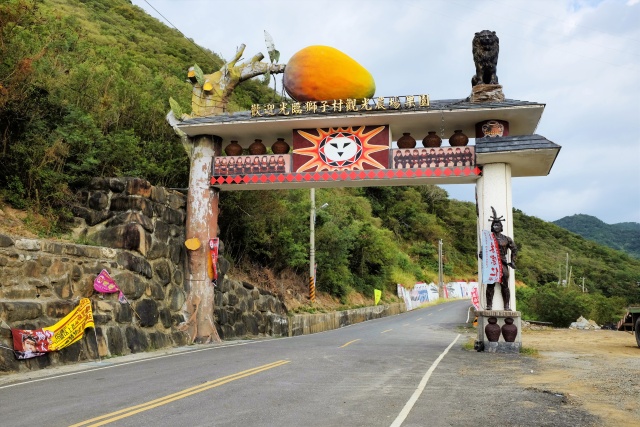
Shizi: Gateway to village
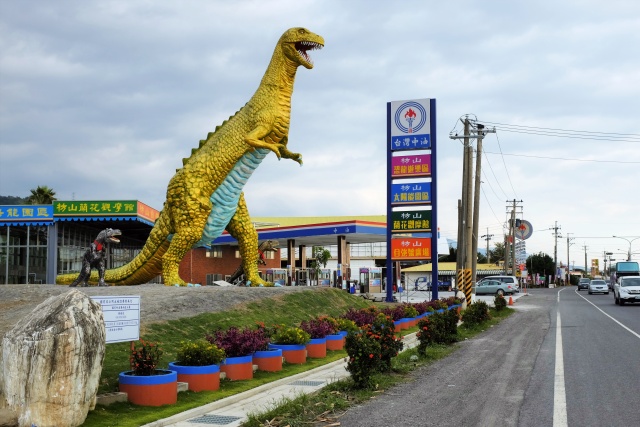
Fangsman: Banner at gas station
As I was cycling along the coast, I counted on sleeping somewhere near a beach. This, however did not work out, I did not find any beach with the kind of facilities I required. In the evening, I arrived in Fenggang— no park, a narrow promenade beside the sea. It seemed as if I would have to sleep somewhere in the bushes beside the road. It got dark and I was still cycling. I spotted a big tourist store, where buses stopped to purchase local produce. The store was closed, the restrooms closed, but in front of it were basins with running water. I washed myself and parked my bicycle under a big tree in the courtyard. Then two ladies arrived and opened the guard house at the entrance. They had no idea I was there, but I felt bad sleeping there without their knowledge, so I walked up to them and asked if I could pitch my tent under the tree. There was a long pause and then the older one pronounced the verdict: NO. Ok, I switched on all the lights I had with me and cycled into the darkness. After 300 meters, I passed a crossroads, after which there was a small park with two small fish ponds and a site for a tent. I moved in and nothing was lacking. I had already washed and over the street was a small store where I purchased a cold beer, so I could sleep well.






